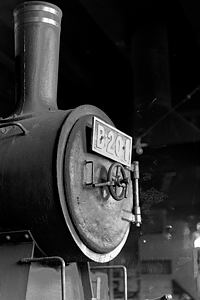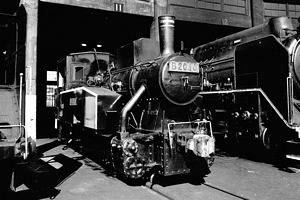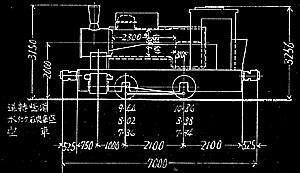
Class B20 No.1
For about five years
No.1 was in safekeeping at the Otaru-Chiko roundhouse.
Japanese
|
1944 - 1972 The smallest shunting Tank-Engine after WW2. |

Class B20 No.1 For about five years No.1 was in safekeeping at the Otaru-Chiko roundhouse. |
|
During WW2, the increased demand for small shunting engines from military plants was a problem.
And there was no common engine design by each maker.
This lack of uniformity was a big problem for rolling stock companies because they were swamped with military orders.
Therefore, during 1942, standard specifications were defined for small shunting engine models. Class B20 was designed as one of these standard shunting engine models during 1943. The class name "B20 ", was also changed from the standards rules. (different from naming rules). "B20" means, four driving wheels, and a weight of 20 tons. At the start, the Ministry of Railways from the Koriyama works made five engines during 1944, but soon the war was over. However, ten more engines were made by the private company, Tateyama Jyuko Co. during 1946. Finally, the number of B20s had a total of 15. However, the demand for small engines was very low after the war. B20_2 and B20_4 thru 8 were operated for yard work at the US Yokosuka base and the neighborhood yard as the Kurihama depot deployment, and of those, B20_2, 5, 6, 8, were used until May 1959. B20_3, 11, and 12 were used mainly in Kansai much like that of Nara and Wakayama yards. Of these, B20_12 was sold to the Gobo Port Railway Co in April 1949. And it was remodeled to a diesel engine DB2012 in June 1954, and it was used until 1970. B20_9, 10, 13-15, were operated in Kyushu, much like that of Nogata and Oita yards. As from the above, 13 of 15 B20s were retired up to 1960. After 1961, the surviving B20s were only two at the Otaru-Chikko depot's No.1 and Kagoshima's No.10. B20_1 was used at Otaru-Chikko depot's yard work and was retired on the 23rd of October 1967. After retirement, she was kept at the Otaru-Chiokko depot, and later she was preserved at Sogo-Park in Iwamizawa city. Afterward, B20_1 was moved to the Manji line Railway museum on the ex-Asahi station site on the closed Manji line. Only B20_10 was active until it's last time at the Kagoshima depot, and she was transferred to the Umekoji Museum during 1972. |
| Primary ran line in last 10 years : |
Kagoshima, Otaru-Chikko yard
| Last line/depot and year : |
Kagoshima depot 1972
| Restored engine (2017) : |
1 (No.10)
| Preserved engine (2017) : |
1 (No.1)
| |

B20-1 at Otaru-Chikko depot, Mar 1969. |

B20-10 Umekoji Museum 1972. |

| Configuration | 0-4-0 | Dimensions Length (mm) | 7000 |
| Engine Weight (Operating tons) | 20.3 | Driver size (mm diameter) | 860 |
| Boiler pressure (Kg/cm2) | 13.0 | Max Tractive effort (tons) | 5.1 |
| Driver Max Power (PS) | 310 | Max Speed (km/h) | 45 |
| Manufactured years | 1944,1946 | Total production | 15 |
| Gauge | 3ft 6in (1067mm) |
Introduction |
Go to Top |